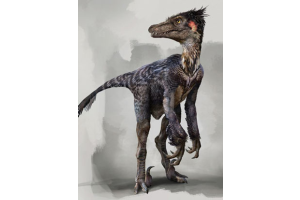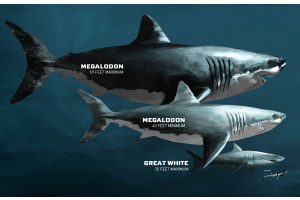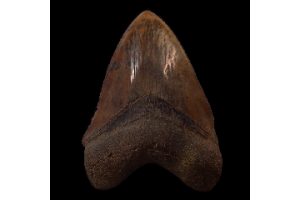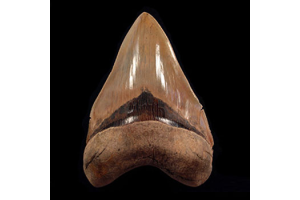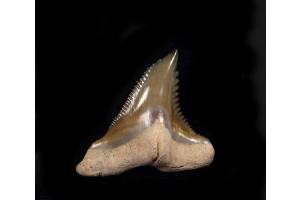Blog
- - December 08, 2025
Fossil collectors often ask what separates an ordinary Megalodon tooth from a truly exceptional specimen. The answer becomes clear once you explore the biggest megalodon tooth. Measuring over seven inches, this rare fossil boasts impressive dimensions. It teaches serious collectors how size, condition, and origin influence value and reveal essential facts about prehistoric marine life. While casual buyers may only consider size, experienced collectors know that real value lies in the details that surround a find of this scale.
Does the Biggest Megalodon Tooth Truly Define Its Value?
Most Megalodon teeth that appear on the fossil market fall between four and five inches in length. These sizes represent common finds and often serve as entry points for new collectors. However, when a tooth exceeds six inches, it moves into the category of rare specimens. If that length surpasses seven inches, it earns attention across the fossil-collecting community.
The tooth then becomes more than a curiosity.
- - December 08, 2025
At Buried Treasure Fossils, we’re constantly in awe of the ancient wonders that lie beneath our feet—and few are as compelling as the legendary Megalodon shark. This colossal predator ruled the oceans millions of years ago and continues to captivate fossil enthusiasts around the globe today.
With a name that literally translates to "large tooth," the Megalodon left behind the most iconic remains: massive, fossilized teeth that give us rare insight into one of the ocean’s most dominant giants. While the full Megalodon shark skeleton may never be uncovered due to the nature of its cartilage-based body, the teeth and spinal centra that have endured tell a captivating story.
From their staggering size to the fossilization process that preserved them for millennia, Megalodon teeth are more than just collectibles—they’re pieces of Earth’s ancient history. As curators of some of the most premium Megalodon fossils available, we at Buried Treasure Fossils are proud to offer a window into the marine
- - December 08, 2025
Collectors, educators, and fossil fans are often surprised to learn how much a tooth’s locality can reveal about the world the Megalodon once ruled. Just a few sentences into exploring prehistoric oceans, we naturally begin talking about the incredible megalodon teeth for sale and the stories they hold. Each specimen reflects a distinct ecosystem, sediment type, and geological history. At Buried Treasure Fossils, we’ve spent decades working with authentic Megalodon specimens from all over the world, and we’ve seen firsthand how dramatically locality shapes a tooth’s color, preservation, and scientific value.
Why Locality Matters When Collecting Megalodon Teeth
Every Megalodon tooth is a time capsule. But where it was found determines how that time capsule was sealed. Factors like mineral content, water depth, volcanic activity, and sedimentation all influence the final appearance of the tooth. When you search for a megalodon tooth for sale, noticing the locality helps you understand
- - December 08, 2025
Collectors often notice something puzzling when browsing for shark teeth. Two specimens can come from the same shark species, yet look completely different and carry very different price tags. These variations are especially common with the snaggletooth shark tooth, known for its bold curves and serrated edges. Shape and price do not always follow predictable rules, which can lead to confusion for both new and experienced buyers. This guide explains how visible differences in these fossils directly affect their value, appeal, and placement in any collection.
What Affects the Price of a Snaggletooth Shark Tooth?
The tooth of the snaggletooth shark stands out because of its varied appearance. Some fossils display a broad curve, while others look more vertical and narrow. The curved specimens usually offer more visual interest and often appear more aggressive in form. Others may show cleaner lines or a more symmetrical shape. These visual traits matter to collectors who prefer bold features
- - December 08, 2025
Not all megalodon teeth are created equal. While each one is a relic of Earth’s ancient oceans and a testament to the sheer scale of the Otodus megalodon - So. Carolina, there’s a wide range in their market value, and for good reason. As fossil enthusiasts, we often ask what makes one specimen command a much higher price than another. The answer lies in a combination of factors: size, preservation, color, provenance, and rarity. These are not just prehistoric artifacts; they are collector’s items where every detail matters. So let’s walk through why the value of these teeth varies so dramatically.
The Rarity Factor: Not Every Tooth Survives Time Equally
The megalodon roamed the oceans millions of years ago, leaving behind countless teeth over time. But that doesn’t mean all of them have survived in collectible condition. The conditions needed to preserve a tooth over millennia are specific and rare. When teeth are found whole, with intact enamel, minimal erosion, and no missing serrations,
- - December 08, 2025
If you love fossils, finding a Megalodon tooth can be an exciting adventure. These giant teeth come from one of the biggest predators in history, and owning one is like holding a piece of the past. Collectors and fossil enthusiasts around the world are fascinated by these prehistoric treasures. With the right locations and guidance, anyone can increase their chances of finding a genuine Megalodon tooth.
Hunting for fossils is not just about luck. Understanding where to search and what to look for makes a big difference. Some spots in the U.S. are known for yielding impressive finds, and exploring them can make your fossil hunt both fun and rewarding.
Why Megalodon Teeth Are So Special?
Megalodon teeth are rare and powerful symbols of history. Each tooth tells a story of an ancient ocean predator that ruled millions of years ago. Many people enjoy the challenge and thrill of finding a Megalodon tooth. It is not just collecting; it is discovering history first-hand.
For beginners, the
- - December 08, 2025
In our work, we take pride in providing collectors and enthusiasts with genuine pieces of history. When we make authentic fossils available, it allows us to share something truly extraordinary. A real claw is not only a fascinating object but also a preserved link to the ancient world. Our specimens come with authenticity guaranteed, and they are collected responsibly from private lands in the northwestern United States.
That assurance can give confidence to those who want to build a collection rooted in both accuracy and integrity. For those seeking a velociraptor claw for sale, authenticity remains the key attraction.
Relics from a Prehistoric Predator
Dromaeosaur dinosaurs, close relatives of the well-known velociraptors, were remarkable predators of the Late Cretaceous. They were under two meters long, weighed about 15 kilograms, and could move with speed and precision. Their anatomy included serrated teeth and a curved claw on each foot, which was designed for gripping and slashing
- - December 08, 2025
The Megalodon is one of the most famous sharks in history. It lived millions of years ago and grew to an enormous size. Collectors and fossil enthusiasts highly value the teeth of this giant shark. Among all locations, New Caledonia produces some of the rarest and most sought-after teeth. These teeth are not just fossils; they are a direct link to prehistoric oceans. Many collectors dream of owning a Carcharocles megalodon tooth from this exotic location.
A Glimpse Into the Past
The Carcharocles megalodon lived during the Middle Miocene period, about 15 to 20 million years ago. This giant predator ruled the oceans and left behind teeth that tell the story of its size and power. Teeth from New Caledonia are particularly special. They come from a rare underwater deposit that spans five square miles at a depth of about 1,000 feet. Today, dredging in this area has stopped, making every tooth from New Caledonia extremely rare.
Collectors value the Carcharocles megalodon because each
- - December 08, 2025
Not every fossil holds the same weight, but a well-preserved megalodon tooth from North Carolina offers more than just a glimpse into prehistoric life. It provides a tangible connection to an apex predator that once ruled ancient seas. Still, not all megalodon teeth meet the standards collectors expect. When you learn how to tell a high-grade specimen apart from the rest, you avoid settling for less and gain a fossil with lasting significance. This guide walks through the key traits that set premium-quality teeth apart, using only the insights found on our fossil listing page.
What Defines a High Grade Megalodon Tooth From North Carolina?
A high-grade fossil tooth tells its story through preservation, color, shape, and completeness. We only label a specimen as top quality when it checks all those boxes. You should expect excellent enamel conservation. That surface should remain strong, smooth, and unflaked. The root must also remain whole and undamaged, not broken or artificially filled.
- - December 08, 2025
Many collectors face a common decision: whether to invest in a Megalodon tooth or a Great White shark tooth. While both fossils offer distinct visual appeal and historical importance, they serve very different purposes depending on what you want as a collector. In short, Megalodon teeth carry weight for those seeking size, rarity, and prehistoric significance. Great White teeth work better for collectors focused on sharp form, living species lineage, and affordability. The megalodon vs great white tooth decision isn’t just about looks. It’s about making a wise, informed choice that suits your goals.
Distinct Origins Define Their Importance
Megalodon teeth come from a long-extinct predator that once dominated ancient oceans more than three million years ago. These sharks measured over 50 feet in length and left behind teeth that reflect their size and power. The teeth are large, thick, and triangular with serrated edges. The Great White shark, however, still roams the ocean today. Fossils



